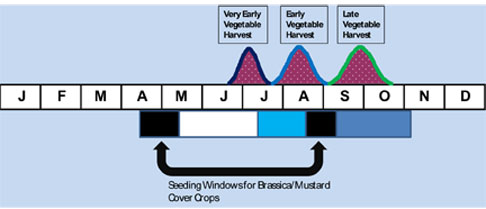Don't miss the sowing window for your brassica cover crops
Editor’s note: This article is from the archives of the MSU Crop Advisory Team Alerts. Check the label of any pesticide referenced to ensure your use is included.
Brassica or mustard cover crops offer multiple benefits in cropping systems. These include: erosion control, weed management, soil fertility improvement, pest and disease control and nutrient recycling. In several crops, such as celery, and onions, we have observed a yield increase of up to 15 percent in muck soils. Growers using brassica cover crops have also reported significant improvements in soil drainage and soil quality.
For growers in Michigan (and other regions with a temperate climate) who cannot afford to skip an entire summer to grow cover crops, there are two options for fitting brassica or cover crops into the rotation system (Figure 1). The spring planting usually begins in early April when conditions become favorable for field operations. The fall planting, (technically late summer planting) runs from late July to late August. In Michigan, success of brassica cover crops planted after August 25 has been variable depending on weather. Germination and early growth is severely affected under cool and dry conditions. Potential problems with late planting include low biomass production and overwintering, especially under mild winters, of young plants. The Brassicas are more susceptible to frost at flowering stage and growers relying on frost to kill the cover crops should avoid planting too late. For the above reasons, this is the time to plant your brassica cover crops in order to optimize the benefits.

Figure 1. Planting windows for Brassica cover crops in commercial
vegetable production systems.
The seeding rates of some of the Brassica cover crops are indicated in table 1. We have revised our seeding rates after several years of observations and results of a density study conducted this summer 2008. In general we have noticed that under high density, competition between plants (intra-specific competition) was very high and resulted in low total biomass production. We have also noticed that optimum seeding rate varies depending on the cultivar used. For example oilseed radish ‘Diakon’ and ‘Defender’ should not be seeded at the same density. Part of this difference is related to seed size. ‘Diakon’ seed is larger than ‘Defender’ seed. Therefore, with the same weights the number of seed planted is higher for the cultivar ‘Defender.’
Table 1. Suggested planting density of some brassica cover crops for optimum biomass production.
| Species | Lb/Acre |
| Oilseed radish ‘Diakon’ | 15 |
| Oilseed radish ‘Defender’ | 10 |
| Brown mustard | 6 |
| Oriental mustard | 6 |
| Yellow mustard | 8 |
| Arugula | 5 |
Dr. Ngouajio's work is funded in part by MSU's AgBioResearch.



 Print
Print Email
Email


